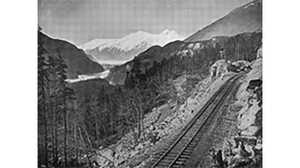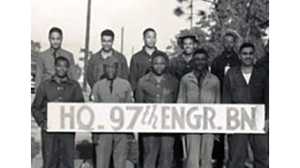The Ferry Disaster at Charlie Lake
Over the course of their eight months building the Alaska Highway, the U.S. Army Corps of Engineers met many hardships. The region's extreme weather and foreign terrain, the project's urgent pace, and the men's relative lack of experience operating complex equipment resulted in several accidents. In all, an estimated 30 men died during the construction of the Alaska Highway. Nearly half of the casualties occurred in the single most devastating of those accidents, a ferry disaster at Charlie Lake.

Rush to Build
Soldiers began arriving up north about a month after President Franklin Roosevelt signed the road-building plan into effect in February 1942. Not knowing when the Japanese might attack, the men were eager to begin their work. Urgency caused members of the 341st Engineers Regiment to make a fatal miscalculation.
Springtime Ice
In mid-May, the unit came to the shores of Charlie Lake, near Fort St. John, British Columbia. Parts of the lake were still frozen and the water's surface was laced with broken, thick slabs of ice. The temperature of the water was only slightly above freezing. Wanting to move on their orders quickly, the men constructed a ferry out of two pontoons and road materials to transport heavy equipment across the lake. To local residents, the plan to cross Charlie Lake was ill-advised. "We were dumbfounded that something like that could've happened because locally it would never have happened," recalled resident Alice Sumner. "To the people who lived around Charlie Lake, they knew they shouldn't be on the lake when the conditions were like that."
Loaded Ferry
Nevertheless, on May 17, despite an ominous sky, the ferry left the shores of the lake loaded with machinery, including a weapons carrier and a D-4 Caterpillar, as well as food supplies and 17 men. As the makeshift transport made its nine-mile crossing, a sudden storm developed, churning up waves and rocking the ferry. With waves and chunks of ice slapping the edges of the craft, the men tried to retreat to the shore. But, the ferry, weighted down by its cargo, was overcome and quickly engulfed by waves. The raft sank in seconds, plunging its 17 passengers into the frigid water.
Local Hero
Gus Hedlin, a local trapper who lived in a cabin on the lake shore, witnessed the disaster. Knowing that only moments in the icy waters could mean certain death, Hedlin jumped into his tiny boat and rowed out to the spot where the raft had sunk. Making three round trips, he pulled five of the submerged men to safety. Twelve of the men on the raft drowned.
Mournful Task
That evening, the engineers spent hours dragging grappling hooks across the water, in hopes of discovering the bodies of their fallen comrades. But the deep, icy water made recovery difficult, and it was not until June 9 that the final body was found.
A Tragic Event
News of the ferry's sinking quickly circulated among the men building the highway, making them wary of what was yet to come in the uncharted territory that lay ahead. However, with the importance of their task in mind, the men continued building. Of all of the fatal accidents during construction of the Alaska Highway, the disaster at Charlie Lake would prove to be the most costly in human lives.







